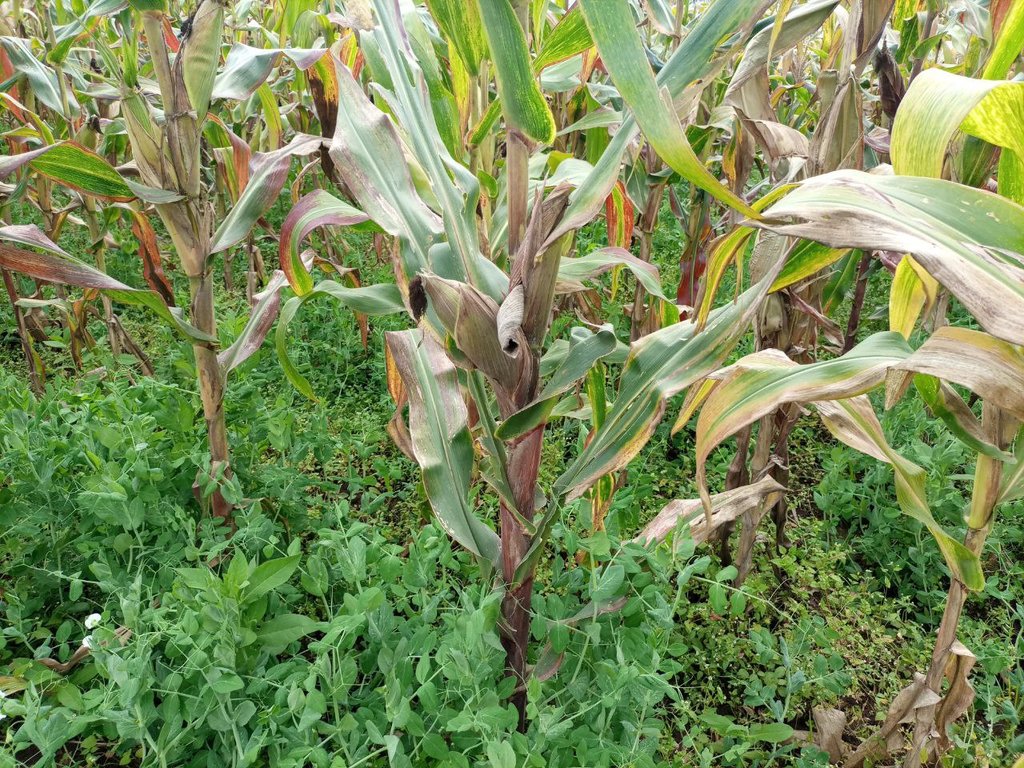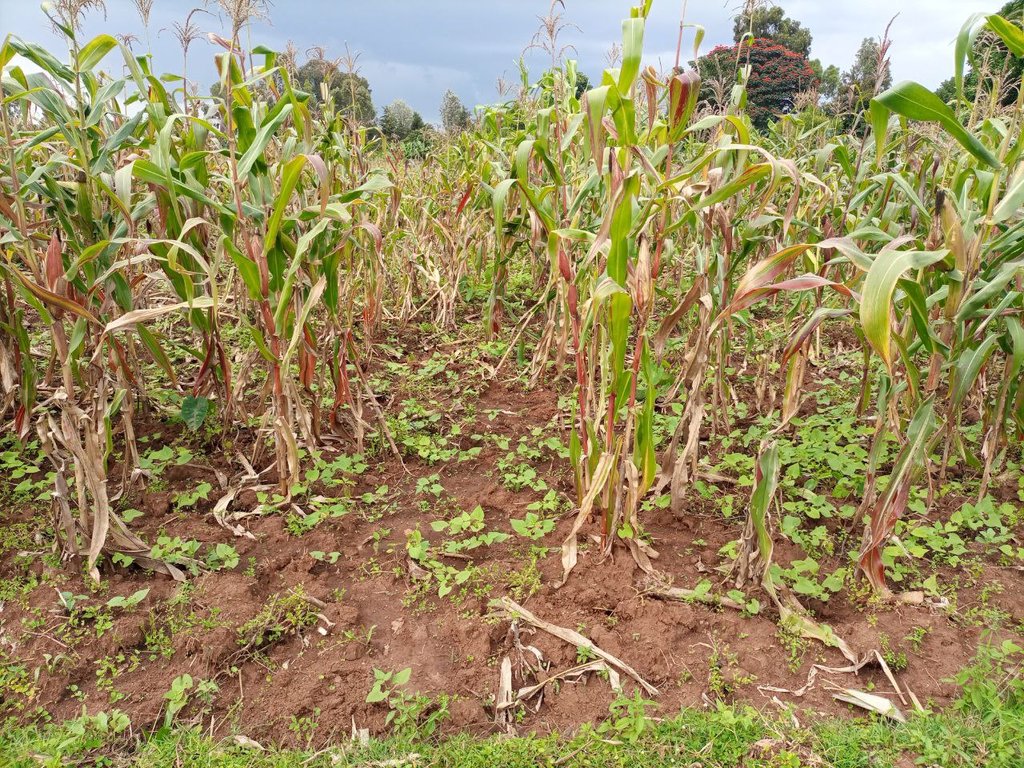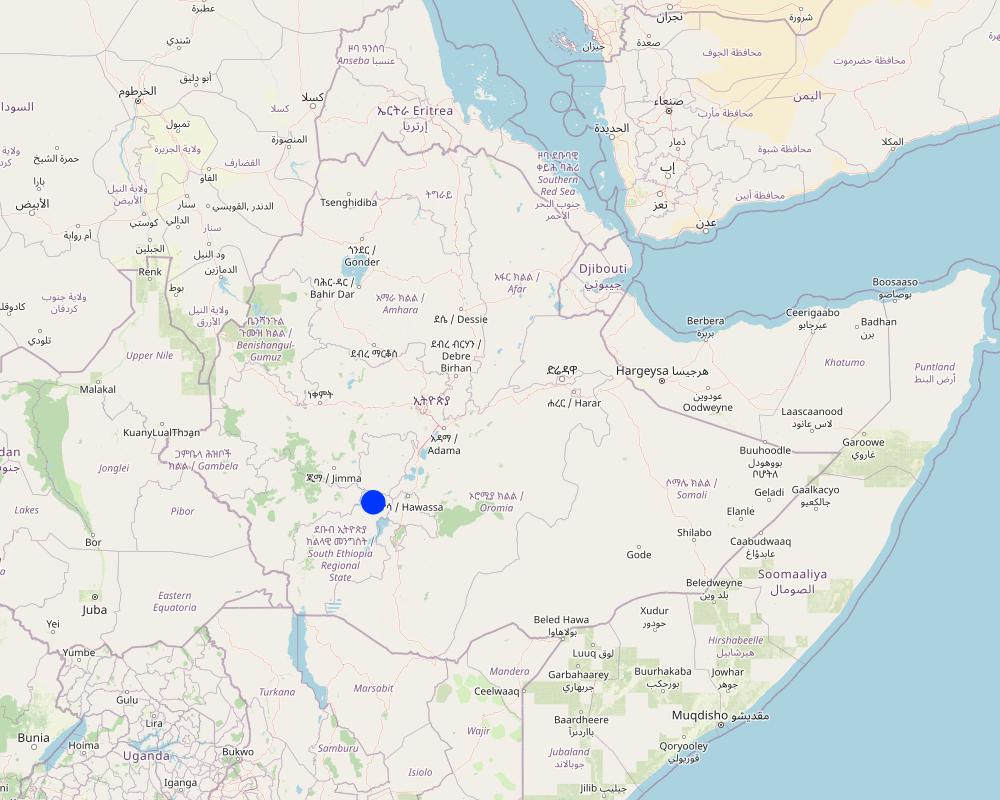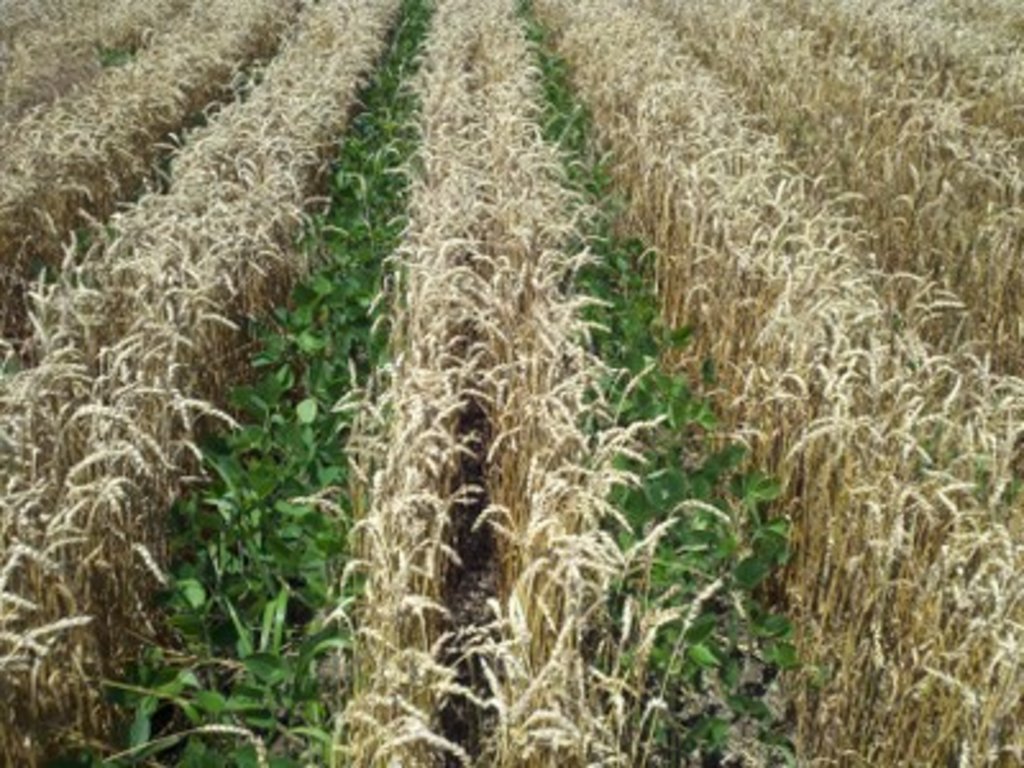Relay Intercropping [เอธิโอเปีย]
- ผู้สร้างสรรค์:
- การอัพเดท:
- ผู้รวบรวม: GERBA LETA
- ผู้เรียบเรียง: Julia Doldt, Kidist Yilma, Noel Templer, Tabitha Nekesa, Ahmadou Gaye, Siagbé Golli
- ผู้ตรวจสอบ: William Critchley, Rima Mekdaschi Studer, Sally Bunning
Kurcheta
technologies_6630 - เอธิโอเปีย
ดูส่วนย่อย
ขยายทั้งหมด ย่อทั้งหมด1. ข้อมูลทั่วไป
1.2 รายละเอียดที่ติดต่อได้ของผู้รวบรวมและองค์กรที่เกี่ยวข้องในการประเมินและการจัดเตรียมทำเอกสารของเทคโนโลยี
วิทยากรหลัก
ผู้ใช้ที่ดิน:
Sankura Goa
Farmer
เอธิโอเปีย
ชื่อของโครงการซึ่งอำนวยความสะดวกในการทำเอกสารหรือการประเมินเทคโนโลยี (ถ้าเกี่ยวข้อง)
Soil protection and rehabilitation for food security (ProSo(i)l)ชื่อขององค์กรซึ่งอำนวยความสะดวกในการทำเอกสารหรือการประเมินเทคโนโลยี (ถ้าเกี่ยวข้อง)
Alliance Bioversity and International Center for Tropical Agriculture (Alliance Bioversity-CIAT) - เคนยา1.3 เงื่อนไขการใช้ข้อมูลที่ได้บันทึกผ่านทาง WOCAT
ผู้รวบรวมและวิทยากรหลักยอมรับเงื่อนไขเกี่ยวกับการใช้ข้อมูลที่ถูกบันทึกผ่านทาง WOCAT:
ใช่
1.4 การเปิดเผยเรื่องความยั่งยืนของเทคโนโลยีที่ได้อธิบายไว้
เทคโนโลยีที่ได้อธิบายไว้นี้เป็นปัญหาของความเสื่อมโทรมโทรมของที่ดินหรือไม่ จึงไม่ได้รับการยอมรับว่าเป็นเทคโนโลยีเพื่อการจัดการที่ดินอย่างยั่งยืน:
ไม่ใช่
แสดงความคิดเห็น:
Intercropping is friendly to the farm. It also increases the "land equivalent ratio" of a plot of land. However, farmers note that surface compaction can be a problem under relay intercropping - because of the frequent field operations required for each of the crops at different times.
1.5 Reference to Questionnaire(s) on SLM Approaches (documented using WOCAT)
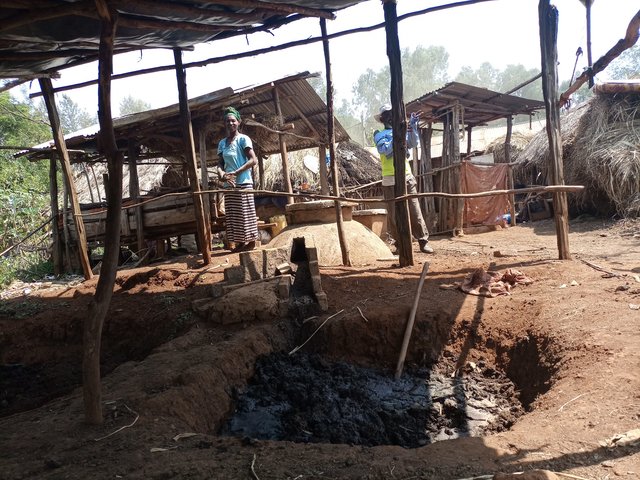
Integrated Soil Fertility Management (ISFM) [เอธิโอเปีย]
The Integrated Soil Fertility Management (ISFM) approach has been adopted under the Integrated Soil Fertility Management Project (ISFM+). It was introduced as a quick-win solution to increase both crop and biomass production through the incremental promotion of varied but complementary technology packages.
- ผู้รวบรวม: GERBA LETA
2. การอธิบายลักษณะของเทคโนโลยี SLM
2.1 การอธิบายแบบสั้น ๆ ของเทคโนโลยี
คำจำกัดความของเทคโนโลยี:
Intercropping is the growing of two or more crops on the same piece of land at the same time or in temporal sequence. Relay intercropping usually involves planting a legume into an established cereal crop. This farming practice has multiple benefits and is a popular among smallholders in Wolaita zone of SNNPR.
2.2 การอธิบายแบบละเอียดของเทคโนโลยี
คำอธิบาย:
Intercropping systems in Sodo Zuria of Waraza-Lasho kebele are characterized by relay intercropping. Under relay intercropping a second crop is planted alongside a growing crop, typically when it has reached its reproductive stage of growth. The practice enables efficient use of available space. In this kebele (lower administrative unit), field peas and haricot beans are commonly intercropped within maize. The seeds of these legumes are either sown in no particular pattern, or simply broadcast, under the main crop, maize. They are planted when the maize comes close to physiological maturity. Intercropping of cereals with legumes improves soil fertility through nitrogen fixation: this system extracts fewer nutrients from the soil than do monocrops. The practice also avoid risks of crop failure, improves effective use of available land, generates additional income and ensures food and nutrition security of the family farmers. Making the right choices about crops and timing of relay planting is crucial. Furthermore, good intercropping demands improved varieties of cereals and legumes. Adequate and timely labour is required also. Conventionally, the farmers till the land up to five times before planting the main crop. In relay intercropping further more land cultivation is essential to plant the companion crop.
Various researchers have reported considerably higher yields from intercropping compared with a pure stand. This can be measured through the “land equivalent ratio” which describes the relative land area required under sole cropping to produce the same yield as under intercropping. Intercropping has been regarded by many farmers as a technique that reduces risk in crop production. It improves carbon sequestration since it enhances biomass accumulation both above and below the surface of the soil. Intercropping is also a form of climate change adaptation strategy as it spreads risks and allows opportunistic use of extra moisture. However, relay intercropping can subject the land to compaction because the companion crops demand extra field operations. These include harvesting the main crops, or sometimes stripping the leaves to reduce the shading effects for the low growing companion crops. There is also extra labour required for weeding and harvesting of the intercrop.
2.3 รูปภาพของเทคโนโลยี
คำอธิบายภาพ:
The photo portrays relay intercropping whereby beans were planted late when the main crops nearly matured. The practice has an immense contribution to the family farmer not only in terms of improving soil fertility but also improving food and nutrition security of the family farmer.
2.4 วีดีโอของเทคโนโลยี
ความคิดเห็น/อธิบายสั้นๆ:
Videos of the technology is not documented.
2.5 ประเทศภูมิภาค หรือสถานที่ตั้งที่เทคโนโลยีได้นำไปใช้และได้รับการครอบคลุมโดยการประเมินนี้
ประเทศ:
เอธิโอเปีย
ภูมิภาค/รัฐ/จังหวัด:
SNNPR
ข้อมูลจำเพาะเพิ่มเติมของสถานที่ตั้ง :
Sodo Zuria
ระบุการกระจายตัวของเทคโนโลยี:
- กระจายไปอย่างสม่ำเสมอในพื้นที่
If precise area is not known, indicate approximate area covered:
- 0.1-1 ตร.กม.
Is/are the technology site(s) located in a permanently protected area?
ไม่ใช่
Map
×2.6 วันที่การดำเนินการ
ถ้าไม่รู้ปีที่แน่นอน ให้ระบุวันที่โดยประมาณ:
- มากกว่า 50 ปี (แบบดั้งเดิม)
2.7 คำแนะนำของเทคโนโลยี
ให้ระบุว่าเทคโนโลยีถูกแนะนำเข้ามาอย่างไร:
- เป็นส่วนหนึ่งของระบบแบบดั้งเดิมที่ทำก้นอยู่ (> 50 ปี)
- ทางโครงการหรือจากภายนอก
- through agricultural extension system
ความคิดเห็น (ประเภทของโครงการ เป็นต้น) :
Intercropping is a common practices since over 5 decades but the distribution limited to a few farmers. The agroecology project/ISFM+ intervention stimulated its pervasive implementation.
3. การจัดประเภทของเทคโนโลยี SLM
3.1 วัตถุประสงค์หลักของเทคโนโลยี
- ปรับปรุงการผลิตให้ดีขึ้น
- อนุรักษ์ระบบนิเวศน์
- ลดความเสี่ยงของภัยพิบัติ
- ปรับตัวเข้ากับการเปลี่ยนแปลงภูมิอากาศของโลก สภาพภูมิอากาศที่รุนแรงและผลกระทบ
- สร้างผลกระทบทางด้านเศรษฐกิจที่เป็นประโยชน์
3.2 ประเภทของการใช้ที่ดินในปัจจุบันที่ได้นำเทคโนโลยีไปใช้
Land use mixed within the same land unit:
ใช่

พื้นที่ปลูกพืช
- การปลูกพืชล้มลุกอายุปีเดียว
Annual cropping - Specify crops:
- cereals - maize
- legumes and pulses - beans
จำนวนของฤดูเพาะปลูกต่อปี:
- 2
ระบุ:
The area received Belg (short rain) and Meher (long rain with summer maximum).
Is intercropping practiced?
ใช่
Is crop rotation practiced?
ใช่
ถ้าใช่ ระบุ:
Rotating cereal crops with root crops.
3.3 Has land use changed due to the implementation of the Technology?
Has land use changed due to the implementation of the Technology?
- No (Continue with question 3.4)
3.4 การใช้น้ำ
การใช้น้ำของที่ดินที่มีการใช้เทคโนโลยีอยู่:
- จากน้ำฝน
3.5 กลุ่ม SLM ที่ตรงกับเทคโนโลยีนี้
- ระบบหมุนเวียน (การปลูกพืชหมุนเวียน การพักดิน การเกษตรแบบไร่เลื่อนลอย)
- การจัดการปลูกพืชร่วมกับปศุสัตว์
- การจัดการความอุดมสมบรูณ์ของดินแบบผสมผสาน
3.6 มาตรการ SLM ที่ประกอบกันเป็นเทคโนโลยี

มาตรการจัดการพืช
- A2: อินทรียวัตถุในดิน/ความอุดมสมบูรณ์ในดิน
- A5: การจัดการเมล็ดพันธุ์ การปรับปรุงพันธุ์
- A6: Residue management
A6: Specify residue management:
A 6.3: collected

มาตรการอนุรักษ์ด้วยการจัดการ
- M5: การควบคุมหรือการเปลี่ยนแปลงขององค์ประกอบของชนิดพันธุ์
- M6: การจัดการของเสีย (การทำ รีไซเคิล การเอากลับมาใช้ใหม่หรือการลดปริมาณ)
3.7 รูปแบบหลักของการเสื่อมโทรมของที่ดินที่ได้รับการแก้ไขโดยเทคโนโลยี

การกัดกร่อนของดินโดยน้ำ
- Wt (Loss of topsoil): การสูญเสียดินชั้นบนหรือการกัดกร่อนที่ผิวดิน

การเสื่อมโทรมของดินทางด้านเคมี
- Cn (Fertility decline): ความอุดมสมบูรณ์และปริมาณอินทรียวัตถุในดินถูกทำให้ลดลงไป (ไม่ได้เกิดจากสาเหตุการกัดกร่อน)

การเสื่อมโทรมของดินทางด้านชีวภาพ
- Bc (Reduction of vegetation cover): การลดลงของจำนวนพืชที่ปกคลุมดิน
- Bl (Loss of soil life): การสูญเสียสิ่งมีชีวิตในดิน
3.8 การป้องกัน การลดลง หรือการฟื้นฟูความเสื่อมโทรมของที่ดิน
ระบุเป้าหมายของเทคโนโลยีกับความเสื่อมโทรมของที่ดิน:
- ลดความเสื่อมโทรมของดิน
- ฟื้นฟูบำบัดที่ดินที่เสื่อมโทรมลงอย่างมาก
4. ข้อมูลจำเพาะด้านเทคนิค กิจกรรมการนำไปปฏิบัติใช้ ปัจจัยนำเข้า และค่าใช้จ่าย
4.1 แบบแปลนทางเทคนิคของเทคโนโลยี
ข้อมูลจำเพาะด้านเทคนิค (แบบแปลนทางเทคนิคของเทคโนโลยี):
Soybean intercropped with wheat. Adopted from https://www.no-tillfarmer.com/articles/4084-lessons-learned-from-2014-modified-relay-intercropping.
ผู้เขียน:
Ohio State University
4.2 ข้อมูลทั่วไปเกี่ยวกับการคำนวณปัจจัยนำเข้าและค่าใช้จ่าย
ให้ระบุว่าค่าใช้จ่ายและปัจจัยนำเข้าได้รับการคำนวณอย่างไร:
- ต่อพื้นที่ที่ใช้เทคโนโลยี
ระบุขนาดและหน่วยพื้นที่:
4 Timad
If using a local area unit, indicate conversion factor to one hectare (e.g. 1 ha = 2.47 acres): 1 ha =:
4 Timad = 1ha
อื่นๆ หรือสกุลเงินประจำชาติ (ระบุ):
Ethiopia Birr (ETB)
If relevant, indicate exchange rate from USD to local currency (e.g. 1 USD = 79.9 Brazilian Real): 1 USD =:
53.6283
ระบุค่าเฉลี่ยของค่าจ้างในการจ้างแรงงานต่อวัน:
400
4.3 กิจกรรมเพื่อการจัดตั้ง
แสดงความคิดเห็น:
We consider documentation of maintenance costs only to put in place the companion crops.
4.4 ค่าใช้จ่ายของปัจจัยนำเข้าที่จำเป็นสำหรับการจัดตั้ง
แสดงความคิดเห็น:
As we opt to focus on the maintenance cost of the relay intercropping, establishment cost is intentionally skipped.
4.5 การบำรุงรักษาสภาพหรือกิจกรรมที่เกิดขึ้นเป็นประจำ
| กิจกรรม | ช่วงระยะเวลา/ความถี่ | |
|---|---|---|
| 1. | Land preparation | Before and during planting of companion crop. |
| 2. | Planting | During the long rain for associated crop. |
| 3. | Weeding | Three weeks after emergency of companion crops seedling onwards. |
| 4. | Harvesting | At the end of harvest season. |
4.6 ค่าใช้จ่ายของปัจจัยนำเข้าและกิจกรรมที่เกิดขึ้นเป็นประจำที่ต้องการการบำรุงรักษา (ต่อปี)
| ปัจจัยนำเข้า | หน่วย | ปริมาณ | ค่าใช้จ่ายต่อหน่วย | ค่าใช้จ่ายทั้งหมดต่อปัจจัยนำเข้า | %ของค่าใช้จ่ายที่ก่อให้เกิดขึ้นโดยผู้ใช้ที่ดิน | |
|---|---|---|---|---|---|---|
| แรงงาน | Land preparation | PDs | 8.0 | 400.0 | 3200.0 | 100.0 |
| แรงงาน | Planting | PDs | 4.0 | 400.0 | 1600.0 | 100.0 |
| แรงงาน | Weeding | PDs | 8.0 | 100.0 | 800.0 | 100.0 |
| แรงงาน | Harvesting | PDs | 8.0 | 100.0 | 800.0 | 100.0 |
| วัสดุด้านพืช | Haricot beans/field peas seeds | kg | 40.0 | 60.0 | 2400.0 | 100.0 |
| ปุ๋ยและสารฆ่า/ยับยั้งการเจริญเติบโตของสิ่งมีชีวิต (ไบโอไซด์) | NSP fertilizer | kg | 50.0 | 45.0 | 2250.0 | 100.0 |
| ค่าใช้จ่ายทั้งหมดของการบำรุงรักษาสภาพเทคโนโลยี | 11050.0 | |||||
| Total costs for maintenance of the Technology in USD | 206.05 | |||||
แสดงความคิดเห็น:
Almost all labor cost, seed and other inputs are covered by land users for maintaining the technology.
4.7 ปัจจัยสำคัญที่สุดที่มีผลกระทบต่อค่าใช้จ่าย
ปัจจัยสำคัญที่สุดที่มีผลกระทบต่อค่าใช้จ่ายต่างๆ:
Usually, the cost is influenced by the economic crisis and high inflation rate experienced in the last few years in Ethiopia. It is also related to global fuel and fertilizer prices as well as other crises which are the potential causes.
5. สิ่งแวดล้อมทางธรรมชาติและของมนุษย์
5.1 ภูมิอากาศ
ฝนประจำปี
- < 250 ม.ม.
- 251-500 ม.ม.
- 501-750 ม.ม.
- 751-1,000 ม.ม.
- 1,001-1,500 ม.ม.
- 1,501-2,000 ม.ม.
- 2,001-3,000 ม.ม.
- 3,001-4,000 ม.ม.
- > 4,000 ม.ม.
ระบุปริมาณน้ำฝนเฉลี่ยรายปี (ถ้ารู้) :หน่วย ม.ม.
1452.00
ข้อมูลจำเพาะ/ความคิดเห็นเรื่องปริมาณน้ำฝน:
Bimodal rainfall is intercepted in the area with a summer maximum from June to September.
ระบุชื่อของสถานีตรวดวัดอากาศที่ใช้อ้างอิงคือ:
Sodo Center Meteorology
เขตภูมิอากาศเกษตร
- กึ่งชุ่มชื้น
High temperature is experienced from December to February.
5.2 สภาพภูมิประเทศ
ค่าเฉลี่ยความลาดชัน:
- ราบเรียบ (0-2%)
- ลาดที่ไม่ชัน (3-5%)
- ปานกลาง (6-10%)
- เป็นลูกคลื่น (11-15%)
- เป็นเนิน (16-30%)
- ชัน (31-60%)
- ชันมาก (>60%)
ธรณีสัณฐาน:
- ที่ราบสูง/ที่ราบ
- สันเขา
- ไหล่เขา
- ไหล่เนินเขา
- ตีนเนิน
- หุบเขา
ระดับความสูง:
- 0-100 เมตร
- 101-500 เมตร
- 501-1,000 เมตร
- 1,001-1,500 เมตร
- 1,501-2,000 เมตร
- 2,001-2,500 เมตร
- 2,501-3,000 เมตร
- 3,001-4,000 เมตร
- > 4,000 เมตร
ให้ระบุถ้าเทคโนโลยีได้ถูกนำไปใช้:
- ไม่เกี่ยวข้อง
ความคิดเห็นและข้อมูลจำเพาะเพิ่มเติมเรื่องสภาพภูมิประเทศ:
The altitude of the place is 1,940 m above sea level.
5.3 ดิน
ค่าเฉลี่ยความลึกของดิน:
- ตื้นมาก (0-20 ซ.ม.)
- ตื้น (21-50 ซ.ม.)
- ลึกปานกลาง (51-80 ซ.ม.)
- ลึก (81-120 ซ.ม.)
- ลึกมาก (>120 ซ.ม.)
เนื้อดิน (ดินชั้นบน):
- ปานกลาง (ดินร่วน ทรายแป้ง)
เนื้อดินล่าง (> 20 ซ.ม.ต่ำจากผิวดิน):
- ปานกลาง (ดินร่วน ทรายแป้ง)
อินทรียวัตถุในดิน:
- ปานกลาง (1-3%)
(ถ้ามี) ให้แนบคำอธิบายเรื่องดินแบบเต็มหรือระบุข้อมูลที่มีอยู่ เช่น ชนิดของดิน ค่า pH ของดินหรือความเป็นกรดของดิน ความสามารถในการแลกเปลี่ยนประจุบวก ไนโตรเจน ความเค็ม เป็นต้น:
The SLM experts describe the soil texture as clay loam.
5.4 ความเป็นประโยชน์และคุณภาพของน้ำ
ระดับน้ำใต้ดิน:
5-50 เมตร
น้ำไหลบ่าที่ผิวดิน:
ดี
คุณภาพน้ำ (ที่ยังไม่ได้บำบัด):
เป็นน้ำเพื่อการดื่มที่ไม่ดี (จำเป็นต้องได้รับการบำบัด)
Water quality refers to:
ground water
ความเค็มของน้ำเป็นปัญหาหรือไม่:
ไม่ใช่
กำลังเกิดน้ำท่วมในพื้นที่หรือไม่:
ไม่ใช่
5.5 ความหลากหลายทางชีวภาพ
ความหลากหลายทางชนิดพันธุ์:
- สูง
ความหลากหลายของแหล่งที่อยู่:
- ต่ำ
5.6 ลักษณะของผู้ใช้ที่ดินที่นำเทคโนโลยีไปปฏิบัติใช้
อยู่กับที่หรือเร่ร่อน:
- อยู่กับที่
แนวทางการตลาดของระบบการผลิต:
- mixed (subsistence/ commercial)
รายได้ที่มาจากนอกฟาร์ม:
- < 10% ของรายได้ทั้งหมด
ระดับของความมั่งคั่งโดยเปรียบเทียบ:
- รวย
เป็นรายบุคคล/ครัวเรือน:
- เป็นรายบุคคล/ครัวเรือน
ระดับของการใช้เครื่องจักรกล:
- งานที่ใช้แรงกาย
เพศ:
- ชาย
อายุของผู้ใช้ที่ดิน:
- ผู้สูงอายุ
ระบุลักษณะอื่นๆที่เกี่ยวข้องของผู้ใช้ที่ดิน:
The farmer piloted conservation agriculture practices. Also, the land users plant woodlots around the periphery of his farmland.
5.7 Average area of land used by land users applying the Technology
- < 0.5 เฮกตาร์
- 0.5-1 เฮกตาร์
- 1-2 เฮกตาร์
- 2-5 เฮกตาร์
- 5-15 เฮกตาร์
- 15-50 เฮกตาร์
- 50-100 เฮกตาร์
- 100-500 เฮกตาร์
- 500-1,000 เฮกตาร์
- 1,000-10,000 เฮกตาร์
- >10,000 เฮกตาร์
พิจารณาว่าเป็นขนาดเล็ก กลาง หรือขนาดใหญ่ (ซึ่งอ้างอิงถึงบริบทระดับท้องถิ่น):
- ขนาดเล็ก
แสดงความคิดเห็น:
Land users owns 3.5 hectares of land.
5.8 กรรมสิทธิ์ในที่ดิน สิทธิในการใช้ที่ดินและสิทธิในการใช้น้ำ
กรรมสิทธิ์ในที่ดิน:
- รัฐ
- รายบุคคล ได้รับสิทธิครอบครอง
สิทธิในการใช้ที่ดิน:
- รายบุคคล
สิทธิในการใช้น้ำ:
- เข้าถึงได้แบบเปิด (ไม่ได้จัดระเบียบ)
Are land use rights based on a traditional legal system?
ใช่
ระบุ:
The land is inherited from the family line but aligned with the constitution adopted by the government that guaranty usufructs to the land.
5.9 การเข้าถึงบริการและโครงสร้างพื้นฐาน
สุขภาพ:
- จน
- ปานกลาง
- ดี
การศึกษา:
- จน
- ปานกลาง
- ดี
ความช่วยเหลือทางด้านเทคนิค:
- จน
- ปานกลาง
- ดี
การจ้างงาน (เช่น ภายนอกฟาร์ม):
- จน
- ปานกลาง
- ดี
ตลาด:
- จน
- ปานกลาง
- ดี
พลังงาน:
- จน
- ปานกลาง
- ดี
ถนนและการขนส่ง:
- จน
- ปานกลาง
- ดี
น้ำดื่มและการสุขาภิบาล:
- จน
- ปานกลาง
- ดี
บริการด้านการเงิน:
- จน
- ปานกลาง
- ดี
แสดงความคิดเห็น:
There is a high unemployment rate. Of course, the area is highly populated. As the site is located closer to the zonal capital they have good financial services particularly access to Bank services such as for saving.
6. ผลกระทบและสรุปคำบอกกล่าว
6.1 ผลกระทบในพื้นที่ดำเนินการ (On-site) จากการใช้เทคโนโลยี
ผลกระทบทางด้านเศรษฐกิจและสังคม
การผลิต
การผลิตพืชผล
แสดงความคิดเห็น/ระบุ:
Increases as the technology best use the available space and surplus moisture in the soil system.
คุณภาพพืชผล
แสดงความคิดเห็น/ระบุ:
Increases as the arrangement allows the relay crop to enjoy the space and available residual nutrients at disposal.
ความหลากหลายของผลิตภัณฑ์
แสดงความคิดเห็น/ระบุ:
Relay intercropping increases the number of crops harvested per unit of land in one season.
พื้นที่สำหรับการผลิต
การจัดการที่ดิน
แสดงความคิดเห็น/ระบุ:
Combining cereal with legumes improves land management by increasing biomass production and combining cereal with nitrogen-fixing legumes that contribute to land management.
ความเป็นประโยชน์และคุณภาพของน้ำ
การมีน้ำดื่มไว้ให้ใช้
คุณภาพน้ำดื่ม
รายได้และค่าใช้จ่าย
รายได้จากฟาร์ม
แสดงความคิดเห็น/ระบุ:
Combining two different types of crop on a farm diversify farm income.
ความหลากหลายของแหล่งผลิตรายได้
ความเหลื่อมล้ำทางเศรษฐกิจ
ภาระงาน
แสดงความคิดเห็น/ระบุ:
Workload increases as it demands additional labor for land preparation, planting, weeding, and harvesting two crops grown in temporal sequences.
ผลกระทบด้านสังคมวัฒนธรรมอื่น ๆ
ความมั่นคงด้านอาหาร / พึ่งตนเองได้
แสดงความคิดเห็น/ระบุ:
Relay intercropping allows ensuring the food and nutrition security of family farmers.
สถานการณ์ด้านสุขภาพ
SLM หรือความรู้เรื่องความเสื่อมโทรมของที่ดิน
ผลกระทบด้านนิเวศวิทยา
วัฐจักรน้ำหรือน้ำบ่า
ปริมาณน้ำ
คุณภาพน้ำ
ดิน
ความชื้นในดิน
แสดงความคิดเห็น/ระบุ:
Soil moisture can exhaustively be used by the companion crop.
สิ่งปกคลุมดิน
การสูญเสียดิน
การอัดแน่นของดิน
แสดงความคิดเห็น/ระบุ:
Frequent farm operation for two different crops increases the pressure that leads to soil compaction.
การหมุนเวียนและการเติมของธาตุอาหาร
ความหลากหลายทางชีวภาพของพืชและสัตว์
การปกคลุมด้วยพืช
มวลชีวภาพ/เหนือดินชั้น C
ความหลากหลายทางชีวภาพของพืช
ลดความเสี่ยงของภัยพิบัติ
ผลกระทบจากภัยแล้ง
การปล่อยคาร์บอนและก๊าซเรือนกระจก
แสดงความคิดเห็น/ระบุ:
Ground cover by two different crops on a temporal basis increases the absorption and storage of carbon.
ภูมิอากาศจุลภาค
6.2 ผลกระทบนอกพื้นที่ดำเนินการ (Off-site) จากการใช้เทคโนโลยี
น้ำที่ใช้ประโยชน์ได้
แสดงความคิดเห็น/ระบุ:
No actual data to forecast the potential off-site impacts.
การไหลของน้ำคงที่และสม่ำเสมอในช่วงฤดูแล้ง
ผลกระทบของก๊าซเรือนกระจก
แสดงความคิดเห็น/ระบุ:
Land covered by crops for extended part of a season contributes to carbon sequestration and reduction of greenhouse gases.
6.3 การเผชิญและความตอบสนองของเทคโนโลยีต่อการเปลี่ยนแปลงสภาพภูมิอากาศที่ค่อยเป็นค่อยไป และสภาพรุนแรงของภูมิอากาศ / ภัยพิบัติ (ที่รับรู้ได้โดยผู้ใช้ที่ดิน)
การเปลี่ยนแปลงสภาพภูมิอากาศที่ค่อยเป็นค่อยไป
การเปลี่ยนแปลงสภาพภูมิอากาศที่ค่อยเป็นค่อยไป
| ฤดู | increase or decrease | เทคโนโลยีมีวิธีการรับมืออย่างไร | |
|---|---|---|---|
| อุณหภูมิประจำปี | เพิ่มขึ้น | ปานกลาง | |
| ฝนประจำปี | ลดลง | ไม่ค่อยดี |
6.4 การวิเคราะห์ค่าใช้จ่ายและผลประโยชน์ที่ได้รับ
ผลประโยชน์ที่ได้รับเปรียบเทียบกับค่าใช้จ่ายในการบำรุงรักษาหรือต้นทุนที่เกิดขึ้นซ้ำอีก เป็นอย่างไร (จากมุมมองของผู้ใช้ที่ดิน)
ผลตอบแทนระยะสั้น:
ด้านบวก
ผลตอบแทนระยะยาว:
ด้านบวกอย่างมาก
แสดงความคิดเห็น:
Maintenance cost for intercropping limited largely to labor and agricultural inputs such as seed and fertilizers.
6.5 การปรับตัวของเทคโนโลยี
- 1-10%
Of all those who have adopted the Technology, how many did so spontaneously, i.e. without receiving any material incentives/ payments?
- 0-10%
แสดงความคิดเห็น:
About 6% of land users adopted the technology on their own motivation.
6.6 การปรับตัว
เทคโนโลยีได้รับการปรับเปลี่ยนเมื่อเร็วๆนี้ เพื่อให้ปรับตัวเข้ากับสภาพที่กำลังเปลี่ยนแปลงหรือไม่:
ไม่ใช่
6.7 จุดแข็ง / ข้อได้เปรียบ / โอกาสของเทคโนโลยี
| จุดแข็ง / ข้อได้เปรียบ / โอกาสในทัศนคติของผู้ใช้ที่ดิน |
|---|
| Improve family farmers diet from the perspective of food and nutrition security. |
| Generate income from the sale of companion legume crops. |
| Improve soil fertility and management of the land |
| จุดแข็ง / ข้อได้เปรียบ / โอกาสในทัศนคติของผู้รวบรวมหรือวิทยากรหลัก |
|---|
| Improve effective resource utilization such as land, labor, and inputs. |
| Insure against total crop failure under unfavorable weather conditions, and pest outbreaks. |
| Improve and maintain soil fertility as the combination is mostly cereal with legumes. |
| Increase total biomass and crop production per unit of land. |
| Pest levels are often lowered in intercrops, as the diversity of plants hampers the movement of certain pest insects and in some cases encourages beneficial insect populations. |
| Reduce soil erosion, lower soil surface evaporation & reduce weed infestation. |
6.8 จุดอ่อน / ข้อเสียเปรียบ / ความเสี่ยงของเทคโนโลยีและวิธีการแก้ไข
| จุดอ่อน / ข้อเสียเปรียบ / ความเสี่ยงในทัศนคติของผู้ใช้ที่ดิน | มีวิธีการแก้ไขได้อย่างไร |
|---|---|
| Demand more labor. | Overlay planting season, and promote row intercropping to simplify the management practices. |
| Relay intercropping triggers soil compaction, | Promote row intercropping for effective utilization of space and reduction of soil compaction. |
| Shortage of best fitting varieties of legume crops for relay intercropping. | Facilitate and improve land users access to suitable companion crops from the nearby research institutes. |
| จุดอ่อน / ข้อเสียเปรียบ / ความเสี่ยงในทัศนคติของผู้รวบรวมหรือวิทยากรหลัก | มีวิธีการแก้ไขได้อย่างไร |
|---|---|
| It is time-consuming as it requires more attention and thus increases intensive management. | Promote row intercropping and overlay planting season to avoid giving separate management practices. |
| There is reduced efficiency in planting, weeding and harvesting which may add to the labor costs of these operations, especially if the practice is at a larger scale. | Plant the main and companion crops simultaneously and apply optimum management practices. |
7. การอ้างอิงและการเชื่อมต่อ
7.1 วิธีการและแหล่งข้อมูล
- ไปเยี่ยมชมภาคสนาม การสำรวจพื้นที่ภาคสนาม
Five persons.
- การสัมภาษณ์กับผู้ใช้ที่ดิน
Only the land user.
- การสัมภาษณ์ผู้เชี่ยวชาญด้าน SLM หรือผู้ชำนาญ
Three experts.
วันที่เก็บรวบรวมข้อมูล(ภาคสนาม) :
17/01/2023
7.2 การอ้างอิงถึงสิ่งตีพิมพ์
หัวข้อ, ผู้เขียน, ปี, หมายเลข ISBN:
Guidelines for Intercropping. Mohler, C. L. and Stoner, K. A. 2009.
ชื่อเรื่อง ผู้เขียน ปี ISBN:
EBook for $24 (https://www.sare.org/publications/crop-rotation-on-organic-farms/guidelines-for-intercropping/)
หัวข้อ, ผู้เขียน, ปี, หมายเลข ISBN:
Raza, M.A. et al. 2019. Growth and development of soybean under changing light environments in relay intercropping system. DOI: 10.7717/Peerji.7262.
ชื่อเรื่อง ผู้เขียน ปี ISBN:
Free online from Research gate
7.3 Links to relevant online information
ชื่อเรื่องหรือคำอธิบาย:
Intercropping: What it is, what it isn't and why we do it.
URL:
https://www.permaculturenews.or/2016/08/12
ชื่อเรื่องหรือคำอธิบาย:
Intercropping Agriculture System
URL:
https://fscluster.org/gaziantep
ชื่อเรื่องหรือคำอธิบาย:
Intercropping: Ergonomic and Efficient Farming
URL:
https://eos.com/blog/intercropping/
7.4 General comments
Specifications under 3.6 such as tillage system, and reside management are not well aligned with the pdf version. So, it is difficult to make choices.
ลิงก์และโมดูล
ขยายทั้งหมด ย่อทั้งหมดลิงก์

Integrated Soil Fertility Management (ISFM) [เอธิโอเปีย]
The Integrated Soil Fertility Management (ISFM) approach has been adopted under the Integrated Soil Fertility Management Project (ISFM+). It was introduced as a quick-win solution to increase both crop and biomass production through the incremental promotion of varied but complementary technology packages.
- ผู้รวบรวม: GERBA LETA
โมดูล
ไม่มีโมดูล



